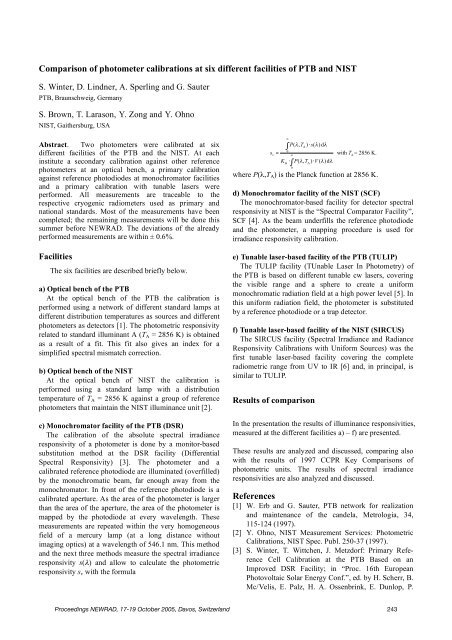Here - PMOD/WRC
Here - PMOD/WRC
Here - PMOD/WRC
You also want an ePaper? Increase the reach of your titles
YUMPU automatically turns print PDFs into web optimized ePapers that Google loves.
Comparison of photometer calibrations at six different facilities of PTB and NIST<br />
S. Winter, D. Lindner, A. Sperling and G. Sauter<br />
PTB, Braunschweig, Germany<br />
S. Brown, T. Larason, Y. Zong and Y. Ohno<br />
NIST, Gaithersburg, USA<br />
Abstract. Two photometers were calibrated at six<br />
different facilities of the PTB and the NIST. At each<br />
institute a secondary calibration against other reference<br />
photometers at an optical bench, a primary calibration<br />
against reference photodiodes at monochromator facilities<br />
and a primary calibration with tunable lasers were<br />
performed. All measurements are traceable to the<br />
respective cryogenic radiometers used as primary and<br />
national standards. Most of the measurements have been<br />
completed; the remaining measurements will be done this<br />
summer before NEWRAD. The deviations of the already<br />
performed measurements are within ± 0.6%.<br />
Facilities<br />
The six facilities are described briefly below.<br />
a) Optical bench of the PTB<br />
At the optical bench of the PTB the calibration is<br />
performed using a network of different standard lamps at<br />
different distribution temperatures as sources and different<br />
photometers as detectors [1]. The photometric responsivity<br />
related to standard illuminant A (T A = 2856 K) is obtained<br />
as a result of a fit. This fit also gives an index for a<br />
simplified spectral mismatch correction.<br />
b) Optical bench of the NIST<br />
At the optical bench of NIST the calibration is<br />
performed using a standard lamp with a distribution<br />
temperature of T A = 2856 K against a group of reference<br />
photometers that maintain the NIST illuminance unit [2].<br />
c) Monochromator facility of the PTB (DSR)<br />
The calibration of the absolute spectral irradiance<br />
responsivity of a photometer is done by a monitor-based<br />
substitution method at the DSR facility (Differential<br />
Spectral Responsivity) [3]. The photometer and a<br />
calibrated reference photodiode are illuminated (overfilled)<br />
by the monochromatic beam, far enough away from the<br />
monochromator. In front of the reference photodiode is a<br />
calibrated aperture. As the area of the photometer is larger<br />
than the area of the aperture, the area of the photometer is<br />
mapped by the photodiode at every wavelength. These<br />
measurements are repeated within the very homogeneous<br />
field of a mercury lamp (at a long distance without<br />
imaging optics) at a wavelength of 546.1 nm. This method<br />
and the next three methods measure the spectral irradiance<br />
responsivity s() and allow to calculate the photometric<br />
responsivity s v with the formula<br />
<br />
<br />
P( , TA<br />
) s( )d<br />
0<br />
sv<br />
=<br />
with TA= 2856 K.<br />
<br />
K P( , T ) V( )d<br />
m A<br />
0<br />
where P(,T A ) is the Planck function at 2856 K.<br />
d) Monochromator facility of the NIST (SCF)<br />
The monochromator-based facility for detector spectral<br />
responsivity at NIST is the “Spectral Comparator Facility”,<br />
SCF [4]. As the beam underfills the reference photodiode<br />
and the photometer, a mapping procedure is used for<br />
irradiance responsivity calibration.<br />
e) Tunable laser-based facility of the PTB (TULIP)<br />
The TULIP facility (TUnable Laser In Photometry) of<br />
the PTB is based on different tunable cw lasers, covering<br />
the visible range and a sphere to create a uniform<br />
monochromatic radiation field at a high power level [5]. In<br />
this uniform radiation field, the photometer is substituted<br />
by a reference photodiode or a trap detector.<br />
f) Tunable laser-based facility of the NIST (SIRCUS)<br />
The SIRCUS facility (Spectral Irradiance and Radiance<br />
Responsivity Calibrations with Uniform Sources) was the<br />
first tunable laser-based facility covering the complete<br />
radiometric range from UV to IR [6] and, in principal, is<br />
similar to TULIP.<br />
Results of comparison<br />
In the presentation the results of illuminance responsivities,<br />
measured at the different facilities a) – f) are presented.<br />
These results are analyzed and discussed, comparing also<br />
with the results of 1997 CCPR Key Comparisons of<br />
photometric units. The results of spectral irradiance<br />
responsivities are also analyzed and discussed.<br />
References<br />
[1] W. Erb and G. Sauter, PTB network for realization<br />
and maintenance of the candela, Metrologia, 34,<br />
115-124 (1997).<br />
[2] Y. Ohno, NIST Measurement Services: Photometric<br />
Calibrations, NIST Spec. Publ. 250-37 (1997).<br />
[3] S. Winter, T. Wittchen, J. Metzdorf: Primary Reference<br />
Cell Calibration at the PTB Based on an<br />
Improved DSR Facility; in “Proc. 16th European<br />
Photovoltaic Solar Energy Conf.”, ed. by H. Scherr, B.<br />
Mc/Velis, E. Palz, H. A. Ossenbrink, E. Dunlop, P.<br />
Proceedings NEWRAD, 17-19 October 2005, Davos, Switzerland 243
















